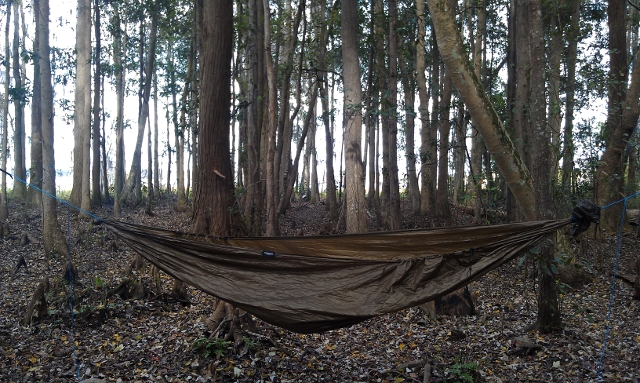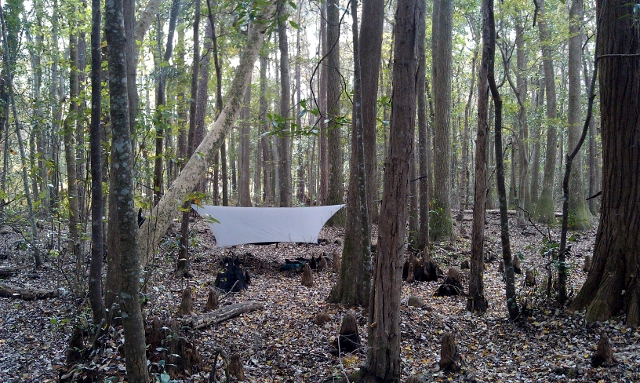The world of hammocks need not be daunting. Yes, it’s a brave new world but one that is certain to lead to a more enjoyable outdoor experience.
Hammocks
We all have different body shapes, sleeping styles, etc. One of the best (and most cost-effective) methods for trying hammocks is to find one to borrow. I highly recommend attending the Annual Florida Hammock Hang. This is held every Martin Luther King weekend at the Buck Lake Recreational Area in Ocala National Forest. Over the course of the weekend you will have the opportunity to examine just about every hammock available and most everyone in attendance will be happy to let you try it out and answer any questions.
Personally my current collection stands somewhere in the neighborhood of 10-12. I have a variety of single- and double-layer designs along with a couple of bridge hammocks for good measure. I have short hammocks and long hammocks. For the most part they all serve a purpose. This is the beauty of hammocks. As I discussed in the print article flexibility is a huge benefit of using hammocks.
During the hot summer months I can choose to take a double-layer hammock with a bugnet. This gives me some protection against biting insects without the need for an undercover of some sort. As the temperature drops I may opt for a single-layer without a net. This will adjust the weight I have to carry a bit since I’ll probably be adding a down underquilt for warmth.
When you’re looking at hammocks don’t be afraid to kick the tires. Think about how you might use it and what features you might need. Do you need a gear bag inside? Do you want a ridgeline to hang your socks and a light? Will you sleep with your head to the left or to the right? All of these can come into play when making your final selection.

Gear pocket inside Light Hiker hammock.
There is a vibrant cottage industry in the hammock world and the vendors are very accommodating to your needs. They also want you to be happy so don’t be afraid to ask questions.
Of all the hammocks I own my current favorite is the Lite Owl from Wilderness Logics. The material is incredibly comfortable against your skin and it has great features and comfort. Perhaps my second favorite is the RidgeRunner from Warbonnet Outdoors. This is the hammock I’m pictured with in the print article.

Hennessy Explorer Ultralight near Osceola Shelter.

Lite Owl at Ocean Pond.
Tarps
Many people only use tarps when it’s raining. I can count on one hand the number of times I’ve gone without. I find that in Florida there’s very little chance of waking up not covered in dew and frankly, that’s not something I enjoy. I also find that a tarp provides some relief from the oppressive summer heat.
My personal recommendation is to use a cat-cut tarp. “Cat” is short for catenary which defines the curve used in the design. This design pitches very taut and makes very little noise in the wind. Rectangular tarps don’t provide that much additional coverage and can be harder to pitch taut. The only rectangular tarp I have is a behemoth and I use it when I’m anticipating severe weather simply because I know it provides such a large area to get under. It also provides many pitching options due to the large number of tie-outs.

The previous image shows a cat tarp. Notice the curved edges on both the end edges and the bottom edge. This is a very effective design and has worked well for me in many storms. Notice how the rectangular tarp has a ripple on the left where it isn’t taut.

Most of the vendors that supply hammocks also provide tarps and other accessories. Personally I own tarps from Jacks R Better, OES, and Arrowhead Equipment. I’ve heard great things about the other vendors as well, though. Unfortunately, while I love my OES tarp I can’t recommend them anymore since the customer service has become atrocious with many people challenging the charges with their credit card companies.
I mentioned in the print article to pick a tarp with at least 6-12″ of additional length beyond the length of your hammock. This is going to dictate (in great part) just how well your setup holds up during a storm. If you have minimal coverage and the wind kicks up you may still find the ends of your gear getting wet. This is one reason I have several. When I switched to 11-foot hammocks my MacCat Deluxe tarp didn’t provide enough coverage.
So let’s talk briefly about coverage. There’s a difference between working and working comfortably. Let’s take the Hennessy for example. Many people (myself included) start with the Hennessy hammock. Many people (myself included) also despise the stock tarp that’s included. It’s not that it doesn’t work. It’s just how it works. When setup correctly the stock tarp will likely keep you dry in bad conditions. The major downside, though, is that it doesn’t provide any additional coverage. If you’re in an extended downpour do you really want to be confined to your hammock? What if you’re starving and want to fix a meal? Under the stock tarp you’re pretty much stuck waiting for the rain to stop.

AHE Toxaway Tarp.
Choosing a tarp (especially when inclement weather comes into play) can make or break your experience. This is another area where the hammock beats a tent. Imagine the joy of looking at your buddy’s tent knowing he can’t get out and stretch his legs while you sit dry and comfortable under the protection of your tarp.

Staying dry under my MacCat Deluxe at Beech Gap.
Cold Weather Protection
Consider this a teaser. I was going to expand upon the article here but you’re in luck. I’ll be covering it in greater detail in a future edition of Footprint.
Suspensions
There are a hundred ways to skin this cat and there really isn’t a “right” answer. Choosing a suspension method is just as personal as picking a hammock and tarp. I learned early on that I didn’t like the lashing method that was suggested with my Hennessy. I also didn’t care for the stock rope that was supplied.
One of the first transitions I made was to a ring buckle system. I attached two rings to each hammock end and ran the tree strap through them. This significantly reduced the time it took to adjust the hammock and get it setup properly.

Ring buckle suspension.
Before delving too deeply into the topic of hammock suspensions I should take a moment to discuss tree straps. You never connect your hammock directly to the tree. Ropes can do damage to the tree’s bark and injure it. Always use tree straps to distribute the load. Straps should be a minimum of 1″ wide. Some people use 2″ straps but I think it’s a bit of overkill. If you carry longer straps you can always make multiple wraps around the trunk.
How long should your straps be? That’s the million-dollar question. It’s safe to say that on average people carry 6-foot straps. Throughout Florida this will almost always be sufficient to get around the pine trees that most of us will deal with. On rare occasion you may need to go longer, though. While camping on Cumberland Island I discovered that the oak tree I was going to hang from was almost too large to use with my 12-foot strap. It’s not uncommon to carry a mismatched set of one 6-foot and one 12-foot. This provides greater flexibility for longer trees or trees that are further apart and still works for smaller trees as well.
Ok, let’s get back to suspensions. While the ring buckle setup worked very well, I knew there were even faster methods out there. I am currently using whoopie slings. A whoopie consists of a very strong hollow-core rope with a fixed loop on one end and an adjustable loop on the other. The rope is spliced into itself to create the adjustable loop and this “bury” section works on the Chinese handcuff principle. When tension (your weight) is applied to the suspension, the rope locks onto itself and won’t slip. When tension is removed you can freely adjust the suspension to make it longer or shorter.

Whoopie.
For the moment this is working the best for me and I have converted most of my hammocks to the whoopie suspension.
